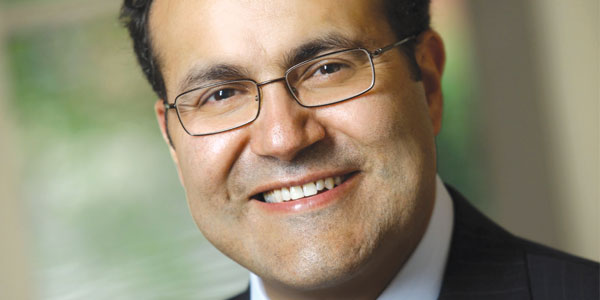
JACKSONVILLE, Fla. — The brain is pulsating in front of me — I never imagined that the brain could pulsate as the heart does. It’s beige, almost light brown. Purple veins and arteries sprawl like a spider web.
I can’t turn my eyes away. If the soul exists, it resides here.
The brain is in plain sight. A little over an hour ago, the surgeon started the complicated procedure of shaving the patient’s head, cutting the skin and skull, and lifting the “dura mater” — a fitting name for a membrane that protects the brain in such motherly fashion.
A 2-inch square segment of bone was cut with a special saw and set aside like a Lego piece. I watch that brain and am amazed not only with the way the organ functions, but also with the doctors who opened up the patient’s skull.
What I get to see is extraordinary. Throughout the surgery, the patient is awake. He’s mildly sedated and given local anesthetics to eliminate pain, but he’s chatting with the doctors and answering their questions. Why is he awake? To be sure that the cuts of the scalpel in his brain won’t affect his speech, his memory, or any other function.
The patient, who we’ll call M, is a 29-year-old who had a brain tumor. He allowed me and my television crew to record the procedure. M put his faith and his brain in the hands of Dr. Alfredo Quiñones and the experts at the Mayo Clinic in Jacksonville, Florida. I would have done the same.
Dr. Q is a living legend. At 49, he has performed some 2,500 brain surgeries. But the most riveting story is how he managed to become one of the world’s most talented neurosurgeons.
Quiñones was an undocumented immigrant in the United States. Nothing has been easy for him. When he was 3, his baby sister died from acute diarrhea. At age 5 he started working at a gas station his father owned in Mexicali, Baja California. The station eventually failed, and Quiñones, at age 19, decided to jump the border into the United States. He was caught and sent back the first time, but that same day he tried again and succeeded.
After that, he was a farmworker in California’s San Joaquin Valley, and then a welder for a railroad company.
One family member had told him he would never escape from the fields. But Quiñones attended a community college to learn English, legalized his immigrant status and later was accepted at the University of California, Berkeley, not far from where he used to pick herbs, fruit and vegetables. Then he went to Harvard Medical School.
Dr. Q likes to say that the same hands that picked tomatoes now are saving lives. He’s not exaggerating.
On weekends he practices boxing, putting up those strong, steady hands that have been washed a million times. In an era when we highlight the things that set us apart, talking to a neurosurgeon is humbling. “We all look alike inside,” Dr. Q told me. No matter the skin color, country of origin or beliefs, the brain unifies us.
Through his Mission: BRAIN foundation, Dr. Q and his team make an annual pilgrimage to Guadalajara and Mexico City to operate on people who cannot afford to pay for operations.
Now Dr. Q has a new goal: to cure brain cancer. He showed me his laboratory, with all its state-of-the-art technology designed to learn how to stop cancer cells that migrate to other parts of the body. (When I learned about John McCain’s brain cancer, Dr. Q was the first person who came to mind.) And it shouldn’t come as a surprise that Dr. Q works with many immigrants just like him, from all around the globe. “We are going to change the world” is his favorite phrase, and he proves it with every surgery.
But let’s go back to the operating room.
M is still awake. With the aid of a powerful microscope, Dr. Q reaches the tumor — and it looks benign. The brain is supremely fragile. Dr. Q digs in it as if it were jelly, with what resembles an ice cream spoon.
The doctor stands up from the operating chair, walks around the table, grabs the patient’s hand and gives it a squeeze. “It’s all right,” Dr. Q says to M. “Everything’s all right.”
Meanwhile, the brain keeps pulsating.
(Jorge Ramos, an Emmy Award-winning journalist, is a news anchor on Univision. Originally from Mexico and now based in Florida, Ramos is the author of several best-selling books. His latest is “Take a Stand: Lessons From Rebels.” Email him at jorge.ramos@nytimes.com.)
Las Manos del Doctor Q
JACKSONVILLE, Fla. — El cerebro está pulsando frente a mí. Nunca imaginé que el cerebro latiera como un corazón. Es beige, casi café claro, y las venas y arterias son moradas, extendidas, como arañas cuidando su presa. No puedo voltear a otro lado. Si el alma existe, está ahí dentro.
El cerebro está a la vista. Hace poco más de una hora que comenzó el complicado proceso de rasurar el cabello, cortar la piel y el cráneo, y levantar la duramadre, la bien llamada membrana que protege maternalmente al cerebro. Un pedazo de hueso, cuadriculado y de unos 5 centímetros por lado, fue cortado con una sierra especial, y la ponen a un lado como pieza de Lego. Veo ese cerebro, y lo único que puedo decir es “qué maravilla.” Me refiero tanto al órgano como a los meticulosos médicos que literalmente abren al paciente.
Lo que me toca ver es extraordinario. A lo largo de toda la operación el paciente está despierto. Está ligeramente sedado, y le han puesto una anestesia local para evitar el dolor, pero conversa con los doctores y responde a todas las preguntas que le hacen. ¿Por qué está despierto? Para asegurarse que los cortes del bisturí en su cerebro no afecten el habla, su memoria y ninguna de sus funciones.
M, un joven de 29 años de edad, tenía un tumor cerebral y me permitió, junto a un equipo de televisión, filmar la operación. M puso su fé y su cerebro en manos del doctor Alfredo Quiñones y de los expertos de la Clínica Mayo. Yo hubiera hecho lo mismo.
El doctor Q es una leyenda. A sus 49 años ha realizado unas 2,500 operaciones de cerebro — pero la historia más apasionante es cómo llegó a ser uno de los más talentosos neurocirujanos del mundo.
Quiñones fue un indocumentado en Estados Unidos. Nada ha sido fácil para él. A los 3 años, su hermana murió por una diarrea. Desde los 5 años le ayudaba a su papá en una pequeña estación de gasolina en Mexicali, Baja California. Pero cuando su papá perdió el trabajo, decidió saltarse la cerca hacia Estados Unidos. Lo agarraron la primera vez, pero el mismo día lo volvió a intentar y pasó. Tenía sólo 19 años de edad.
Trabajó en la agricultura en el norte de California, y luego como soldador. Un familiar le dijo que nunca dejaría los campos de cultivo. Pero se equivocó. Quiñones fue a un colegio comunitario para aprender inglés, legalizó su situación migratoria y más tarde fue aceptado en la Universidad de California en Berkeley, a un ladito de donde levantaba hierbas, frutas y verduras. A eso siguió la escuela de medicina en Harvard.
Al doctor Q le gusta decir que las mismas manos que levantaron tomates ahora salvan vidas — y no exagera.
Hace ejercicios de boxeo los fines de semana, pero sus manos son pequeñas y delgadas, lavadas un millón de veces, estables, precisas, morenas. En esta época en que se destacan tanto las cosas que nos diferencian, es aleccionador hablar con un neurocirujano. “Todos nos vemos iguales,” me dice el doctor Q. No importa el color de piel, país de origen o ideas. El cerebro nos une, física y literalmente.
A través de su fundación BRAIN, Quiñones hace un peregrinaje anual a Guadalajara y a la Ciudad de México para operar a personas de bajos recursos. Y ahora tiene una nueva meta: encontrar una cura para el cáncer cerebral. Me enseñó sus laboratorios, con la última tecnología, para aprender cómo ponerle un freno a las células cancerosas que emigran a otras partes del cuerpo. (En él fue el primero que pensé cuando me enteré del cáncer del senador John McCain.) Y no debe sorprenderle a nadie que el doctor Q trabaje con muchos inmigrantes como él, de todas partes del mundo.
“Vamos a cambiar el mundo” es su frase favorita, y con cada operación nos demuestra que es posible. Pero regresemos a la sala de operación.
M sigue despierto. El doctor Q llegó hasta su tumor — con la ayuda de gigantesco microscopio para ver lo más chiquito — y todo parece indicar que es benigno. El cerebro es increíblemente frágil. Lo escarba como si fuera una gelatina, con una cucharita parecida a las que se usan para el helado.
El doctor deja su silla donde opera, le da la vuelta a la mesa, toma la mano del paciente y le da un fuerte apretón. “Todo está bien,” le dice Q a M. “Todo está bien.”
Mientras, el cerebro sigue pulsando.
(Jorge Ramos, periodista ganador del Emmy, es el principal director de noticias de Univision Network. Ramos, nacido en México, es autor de nueve libros de grandes ventas, el más reciente de los cuales es “A Country for All: An Immigrant Manifesto”.)









